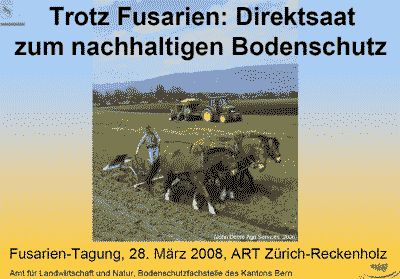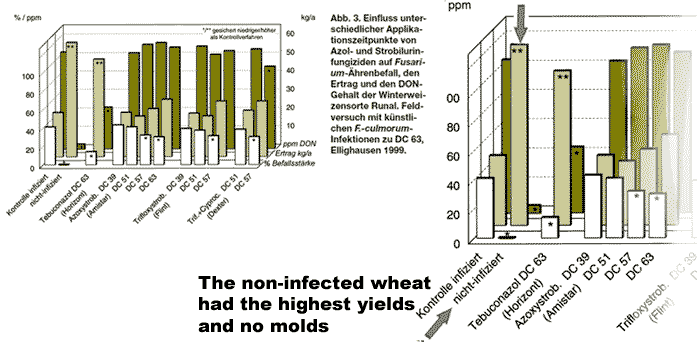Our crops grow up in this most concentrated poison sauce they can just barely tolerate.
But consumers too often not?
Well, that’s not entirely accurate: The pesticide concentration reaches now levels that can even sicken the crops.
The urban myth of the high-yielding but sensitive modern varieties.
“We need pesticides because the modern varieties have high yields, but are more vulnerable than the old, robust varieties of our ancestors?”
Our arable plants are (almost always) extremely robust giants.
With good agricultural practices, damages are minimal, insecticides and fungicides are almost always unnecessary, and herbicides can be replaced by machines.
Pesticides are a superfluous but lucrative and devastating scam.

“Le malade imaginaire”
Wheat is usually treated preventively with azole fungicides suspected of causing cancer.
Although only one wheat type molds: The glyphosate no-till wheat.
It can’t stand the record amounts of glyphosate? Well, only if it is grown after corn, and to make matters worse, if it is one of the very few varieties susceptible to mold.
So why preventive fungicide applications? The governmental agricultural research legitimizes them with a single, debunking misquote: “In years of epidemic occurrence, yield losses of 20 to 30% can occur.” (1). And the “forgetting” of the title of this older publication: “Only resistant varieties help against fusariosis” (=mold).
As a result of this ancient expertise, the breeding of resistant wheat varieties took place, the susceptible varieties disappeared long time ago, together with the mold, due to a lack of demand.
Preventive fungicide treatments, however, became established.
“Before sowing, marinate the seeds well in a strong mold sauce”
No farmer would come up with such an idea.
But agricultural research would. In almost all of their fungicide experiments, the seeds get “oculated”, i.e. artificially infected.

Statistical columnar forests can be intimidating to the non-statistic-initiated. But they also reveal embarrassing scoops: The non-infected wheat did not mold and had the best yield.
Even better than the infected wheat treated with the best fungicide, an azole. The best-selling azole has just been banned by the EU because it is suspected of causing cancer. The less dangerous fungicides, strobulins and co. had no effect against the mold.
Is this now a proof for the protective effect of the azole fungicides? Only if the farmer marinates their wheat seed in a mold sauce before sowing them…
Of course, science prohibits the transfer of pesticide effects from artificially infected plants to non-infected plants. Because with a normal, minimal mold infestation, the protective effect of the fungicides would be too low for a (statistically significant) scientific proof.
The effect of Azole fungicides on non-artificially infected grain has hardly ever been measured: The scientific publications warn that fungicides can cause mold damage. (And herbicides stop the growth of maize for one month).
The industries now propagate the use of up to four fungicides per year in the wheat. They suggest “relevant” increases in yield, but avoid the word “significant”, i.e. scientifically confirmed.
Non-oculated fungicide experiments in our agricultural research are limited to (extreme locations (damp, cold, montane) outside the agricultural area, the fields infested with (non-toxic) snow mold suggest Hollywood-style horror visions.
Conflict of interest – the persiflage of science.
The alleged scientifically confirmed successes of fungicides in the research measurements of the agricultural departments are based on inadmissible conclusions. Faking an alleged success on the basis of inadmissible methodological manipulations and interpretations is not only scientifically forbidden, but also legally.
Anyone who deliberately fakes an alleged need for cancer-suspected poisons in food approves and helps that every second person will develop cancer.
Are such manipulated pesticide evidences the norm?
The evidences for the protective effects of the pesticides in the approval documents are secret. Only summaries may be viewed, which prevents errors in methodology from being detected.(2)
Are these skillfully orchestrated hazard strategies the normal working way of our administrations?
No. But they increasingly seem to be an indispensable prerequisite for a career in the higher floors of the administrations.
The worst possible professional practice
The agricultural ministries legitimize the alarmism of their worst possible theory with corresponding cultivation recommendations.
Quiz question: Why is wheat nowadays grown after corn, a very robust crop, known as exhausting the soils? Why did our basic food wheat lose its millennia-old optimal position in the crop rotation? (A crop rotation starts after a meadow, because this most natural form of agriculture remedies all imbalances and damages).
The subsidies are designed in a way that farmers earn more with corn before wheat than vice versa? The status of modern consumers is below the livestock.
With their “eco-subsidies”, our ministries of agriculture are forcing an optimized combination and concentration of pesticide suspected of being cancerous in our basic food crop wheat: No-till guarantees maximum amounts of glyphosate, the best starting position is given to the corn, the least suitable previous crop for wheat. And as this can lead to mold in susceptible varieties…, all conventional wheat is treated with fungicides suspected of being cancerous.
On the other hand, the economically optimal crop rotation got… banned: In the stubble wheat combination (= double wheat) the second wheat gets drilled into the first wheats stubble, tillage is unnecessary.
Instead of avoiding problems preventively thanks to a best professional practice, the agricultural ministries propagate an optimized poison accumulation, this principle applies even more to the only real endangered arable crop: They recommend at least 13 fungicide treatments for the potatoes, in addition to the other pesticides.
.
Double standard
If the scientific evidence shows that a pesticide is dangerous, the agricultural ministries approve it, or even subsidize it. If the data show no benefits of the pesticides, the (government) researchers pretend a success, without any regard to the measured data.
As compensation, they ban highly profitable farming methods without any scientific evidence that they could be problematic. And harmless farmers varieties.
Science and Pesticides
The evidence of the effectiveness of the pesticides
• are either faulty (statistically insignificant or methodologically incorrect, so they cannot be scientifically confirmed)
• or absent (i.e. secret) for over 95% of the pesticides. However, science accepts only published evidence that meets all epistemological requirements; secret evidence or summaries are not scientifically acceptable evidence.
For almost all pesticides, science cannot recognize their alleged efficacy.
Probably the greatest taboo of our era.
The questionable benefits of pesticides (or lack of scientific evidence) match the lack of need for pesticides.
Every second person is diagnosed with cancer, which in itself is a (statistically highly significant and scientifically) incontestable proof that the toxic pollution caused by pesticides is far too high.
.

How to sell an unnecessary cancer risk
Sources:
(1) Schachermayr, G. Fried P.M. (2000): Problemkreis Fusarien und ihre Mykotoxine. Agrarforschung 7 (6), 252-257
(2) EU: (91/414/EWG) Art.14 , 283/2013 (EG) Nr. 1107/2009 App II, Switzerland: PSMV 916.161, 52, 3 g
